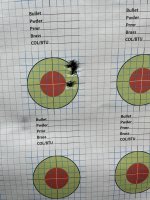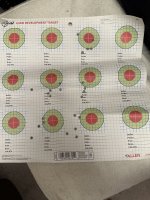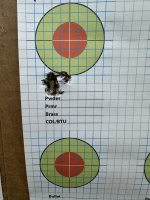There aren't that many things that could cause a "one hole" load at 100 yards to blow up to a 2 MOA load at 200 yards.
1) As
@matt33 mentions, parallax would be the first thing I'd look at. While 100 to 200 yards isn't a large yardage difference, it could be enough in parallax adjustment that if either you're off in dialing it in or the scope is screwed up in that regard, that it could be a sizable portion of what you're seeing. I'm still skeptical that parallax could be so far off that it would be entirely responsible, but I'd start there.
To Test:
First, make sure you've got your parallax set correctly. Move your head side to side and up and down. The reticle should not move in relation to the target as you move your head. Adjust it until it doesn't.
Second, change the parallax relatively significantly and see if the scope's behavior changes (it should). If it doesn't, you may have a parallax issue with the scope.
Third, put another scope on it and test.
2) It could be you. Granted, if you're getting a one-hole group at 100 yards, you should be able to do well at 200. However, if your one-hole groups are from 3 shots, try 10 or 20 at each range and see what happens. Note that when I shoot for groups at 100 (or 200, or 300 - any range where I can see the bullet holes through the scope), I use orange dot stickers ($6.99 for 1000 1" dots at Amazon) and always dial in like 1/2 a mil to one side or another. The reason for this is that you always want a clean point of aim. Otherwise you end up sort of chasing the group, which opens everything up.
To Test:
First, are you zooming in with your scope when you go to 200? Try zooming out. It seems counter intuitive, but I find that more I zoom out (within reason and only out so far), the tighter my groups get. This is because when you're zoomed in more, you tend to chase the wobble. Not that this would account for everything you're seeing, but it could contribute.
Second, find someone who really knows precision shooting to check out everything. No offense to your law enforcement friend, but some of the law enforcement folks I've met that have had sniper training are not what I'd call experts in precision shooting. Know that most sniper engagements are less than 200 yards - training for that vs. hitting a 1 MOA target at a mile are two completely different regimens and skillsets. Maybe your friend is good, but ideally you want someone who has had a lot of experience with precision shooting across a number of different rifles.
With all that said, it's entirely possible that something with the bullet-load-barrel combo could cause a load that works at 100 to fall apart at longer ranges. This was proven to me in the first long range training I ever took - and Jeff Siewert devotes some pages to the subject in his book. However, it's highly unlikely that with today's quality components in a modern rifle you'd be creating a condition that would cause this - AND - while I've seen groups fall apart at like 500-600 yards, getting such a massive degradation while going from 100 to 200 feels like it has to be something else.
Lastly, while I doubt this is causing your issue, Starline brass works fine in an AR. For a precision bolt rifle, get some Lapua...




